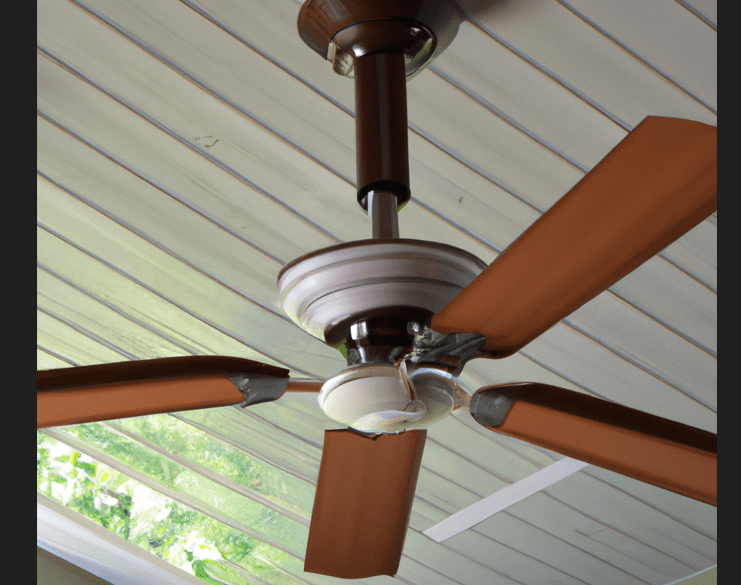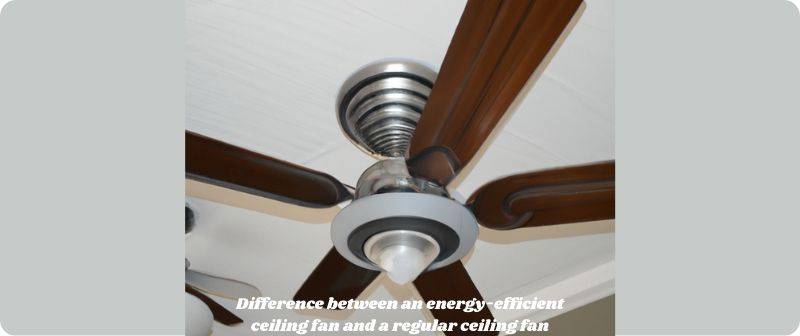As the summer heat approaches, many of us will be turning to our trusty ceiling fans to keep cool.
But have you ever stopped to consider the energy efficiency of your fan? While a regular ceiling fan may do the job of circulating air, it could be costing you more in the long run.
On the other hand, an energy-efficient ceiling fan not only keeps you cool but also saves you money on your energy bills and helps reduce your carbon footprint.
So, what exactly is the difference between these two types of fans? Keep reading to find out.
Definition of energy-efficient ceiling fan

An energy-efficient ceiling fan is a type of fan that is designed to consume less energy while providing powerful and efficient air circulation.
These fans are typically equipped with features such as DC motors and Energy Star ratings, which help to reduce energy consumption and lower costs.
Additionally, energy-efficient ceiling fans are often equipped with advanced airflow technology that maximizes the amount of air moved while minimizing the amount of energy consumed. This means that energy-efficient ceiling fans can provide the same level of cooling as regular fans, but with less energy consumption.
Furthermore, energy-efficient ceiling fans are also designed with energy-saving lighting options, like LED lights that can be used to reduce energy consumption even further.
The overall goal of energy-efficient ceiling fans is to provide the same or better performance while reducing energy consumption and saving costs over time.
Importance of energy efficiency in home appliances
Energy efficiency is a crucial aspect to consider when purchasing any home appliance, as it directly impacts both your energy bills and the environment. An energy-efficient appliance will consume less power and, therefore, reduce the amount of energy required to power it.
This not only saves you money on your energy bills in the long run, but it also helps to reduce the overall demand for energy, thus reducing the strain on power plants and other energy sources.
Additionally, by using less energy, energy-efficient appliances also reduce their carbon footprint, which is beneficial for the environment. Investing in energy-efficient home appliances is a win-win situation, as it helps to save money while also contributing to a more sustainable future.
Energy-Efficient Ceiling Fan Features
DC Motor
DC Motor (Direct Current Motor) is another technology that has been gaining popularity in energy-efficient ceiling fans. Unlike traditional AC (Alternating Current) motors, DC motors are designed to convert electrical energy more efficiently into mechanical energy.
This means that DC motors consume less energy, making them a more energy-efficient option. Additionally, DC motors are known to generate more torque, which means that they can produce more airflow even at a lower speed. This makes them more effective at circulating air in large rooms.
Another advantage of DC motors is that they are more durable than traditional AC motors. They have fewer moving parts which mean they require less maintenance and have a longer lifespan. This can save you money in the long run, as you will not have to replace your fan as frequently.
Energy Star rating
Energy Star rating is a certification given by the Environmental Protection Agency (EPA) to products that meet certain energy efficiency standards.
Energy Star-rated ceiling fans are known to help save money and energy up to 20% compared to regular fans.
This can lead to significant savings on your energy bills over time, which makes it an ideal option for those looking for ways to reduce their energy consumption and costs.
Additionally, Energy Star-rated fans are designed to work efficiently and effectively, which means they can provide a comfortable environment while consuming less energy.
Airflow and CFM
Airflow and CFM (Cubic Feet per Minute) are two important factors to consider when looking for an energy-efficient ceiling fan.
CFM measures the amount of air that a fan can move in one minute. A fan with a high CFM rating will be able to move more air, making it more effective at circulating air in a room.
Energy-efficient fans typically have higher CFM ratings than regular fans, which means they can keep a room cool faster and more efficiently.
A high CFM rating is important when you are looking for a fan that can cool large rooms or open spaces, as it can help to circulate the air more effectively.
Additionally, a high CFM rating also means that the fan can move more air per minute, which can help to keep the air in a room fresher and cleaner.
SEE: Most Energy-Efficient Ceiling Fans
How to Choose an Energy-Efficient Ceiling Fan
When it comes to choosing an energy-efficient ceiling fan, it is important to start by considering the size of the room and the fan. A too-small or too-big fan for a space won’t properly circulate the air, leading to less efficient performance. Therefore, it’s crucial to choose a fan that fits your space.
A good way to determine the right size of a fan is to measure the length and width of your room and multiply them together, then consult the sizing guide to pick the right size of the fan, and make sure that your ceiling has enough support to handle the fan’s movement and weight.
Motor
Motor considerations are also essential when it comes to energy efficiency. DC motors are known to consume less power and generate more torque, making them ideal for energy-efficient fans. On the other hand, Energy Star-rated fans are a good choice for those on a budget, they help save money and energy by up to 20%.
LED lights
Additional features such as LED lights can also play a role in the energy efficiency of a ceiling fan. LED lights are energy-efficient and last much longer than traditional incandescent bulbs, which means you won’t have to replace them as often.
They also provide a brighter and more consistent light than traditional bulbs, making them a great option for reading or other tasks that require bright light.
Conclusion
When choosing an energy-efficient ceiling fan, it is imperative to consider the key points highlighted in this article. The size of the room, the motor, and any additional features such as LED lights all have an impact on the energy efficiency of a ceiling fan.
Energy-saving appliances not only save you money in the long run, but they also benefit the environment as well. In addition to reducing energy consumption and costs, energy-efficient ceiling fans also contribute to a reduction in carbon footprint. Energy-efficient ceiling fans are worth the effort.
FAQs
What are the benefits of an energy-efficient ceiling fan?
Energy-efficient ceiling fans are eco-friendly and cost-effective.
Energy savings are the main benefit of an energy-efficient ceiling fan.
It saves energy by using less power. Energy-efficient ceiling fans provide strong airflow with reduced energy use.
You may enjoy a comfortable and cool environment without worrying about the expense. Most energy-efficient ceiling fans are whisper-quiet, allowing you to relax in peace.
Many energy-efficient ceiling fans include built-in LED lights that last longer and use less electricity.
Energy-efficient ceiling fans save money and the environment.
How does the motor affect the energy efficiency of a ceiling fan?
The motor is a key factor in deciding how energy-efficient a ceiling fan is when it comes to how much power is used.
The fan’s motor, which drives the blades’ movement and moves air about the space, is its beating heart. The energy efficiency of a fan can be significantly impacted by the type of motor it uses.
For instance, it is well known that DC motors are considerably more energy-efficient than their AC equivalents.
This is because DC motors consume less energy and result in significant electricity bill savings as compared to AC motors when producing the same amount of torque. DC motors are appreciated for their almost silent operation as well.
AC motors, on the other hand, use more energy and typically make more noise. While the wattage difference between energy-efficient fans and normal fans may be negligible for some, it may be substantial for others.
As a result, when selecting an energy-efficient ceiling fan, it is crucial to take the kind of motor into account because it can significantly affect power consumption and overall energy savings.
What is the difference in airflow and CFM between an energy-efficient ceiling fan and a regular fan?
Ceiling fan energy efficiency depends on airflow and CFM.
CFM measures the airflow of an energy-efficient ceiling fan. Energy-efficient fans have higher CFM ratings, improving room ventilation and air circulation.
Advanced aerodynamic blades on energy-efficient fans boost airflow and minimize drag, improving performance.
Regular fans have lower CFM ratings and less innovative blade designs, resulting in less efficient airflow and higher energy consumption.
An energy-efficient ceiling fan can reduce your energy bills and enhance the air quality and comfort of your home.
Are LED lights on a ceiling fan considered energy efficient?
LED lights on a ceiling fan are considered energy efficient as they use less power and have a longer lifespan than traditional incandescent bulbs.
This not only helps save on energy costs but also reduces the need for frequent bulb replacements. Additionally, LED lights offer a wider range of color options and dimming capabilities, allowing for greater control over lighting and atmosphere in a room.
How does the size of a ceiling fan impact its energy efficiency?
The size of a ceiling fan plays a crucial role in its energy efficiency. A too-small or too-large fan for a space won’t properly circulate the air, resulting in less efficient performance.
Therefore, it’s important to choose a fan that fits the room size and has the appropriate airflow and CFM to properly circulate the air.
Additionally, the fan’s motor should also be considered when assessing energy efficiency, as options like DC motors and Energy Star-rated fans can provide increased energy savings.
- Which Robot Lawn Mower Is Right for You? A Comparison of 6 Common Types - July 12, 2025
- 25 Neutral Boho Bedroom Inspiration Cozy, Calm & Beautiful - July 12, 2025
- 26 Backyard Shower Ideas That Turn Your Outdoor Space Into a Spa - July 11, 2025

